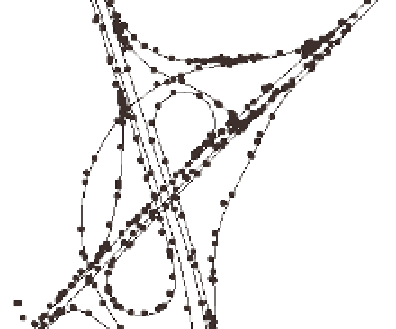Global Positioning System Reference
In-Depth Information
a major highway interchange containing ramps, overpasses, and underpasses. This example
indicates that multiple spatial mismatches may occur at interchanges.
As a consequence of the map-matching problem, any subsequent usage, visualization,
computation, evaluation, analysis, planning, and decision-making may be impacted
negatively and produce erroneous perceptions. For example, the calculated cumulative
distance traveled by a vehicle along a roadway network is incorrect and, therefore,
calculated values for performance measures such as fuel consumption or decision
management tools that depend upon cumulative distance are wrong. Additionally, any non-
spatial data collected from vehicle sensors such as speed data or emission levels are
associated with incorrect roadway centerlines. Furthermore, GPS data points might be
incorrectly assigned to roadways along which no measurements were ever taken affecting
transportation applications such as road use charging based on the total mileage driven by
vehicle (Cozzens, 2009; Sheridan, 2011). The need to overcome spatial mismatches in ITS
applications is a major motivation for implementing map-matching algorithms.
Fig. 2. GPS Data Points Collected by a Vehicle While Traveling at a Highway Interchange
Section 2 presents a literature review of map-matching algorithms developed to solve
spatial ambiguities. Section 3 describes the proposed topological decision-rule map-
matching algorithm and an example of its implementation. Results of the performance
analysis with real spatial data are presented in section 4. Finally, section 5 presents a
summary and the main conclusions of this chapter, and further research topics to be
addressed.
2. Map-matching methods
The problem of resolving spatial ambiguities has been widely studied over the years. The
following map-matching algorithms are described in the literature with different levels of
complexity ranging from simple geometric techniques to complex, advanced approaches.
2.1 Semi-deterministic map-matching
The earliest map-matching algorithm, before GPS was developed in the 1970's, followed a
semi-deterministic model (French, 1989). This model assumes that the vehicle has an initial


Search WWH ::

Custom Search